
| |
 |
| This photo shows the large 60 pot unit as viewed from the front, with the
worm beds to the left. In the center of the photo you see the hood of the 1000 watt Metal Halide light which serves this unit. The bright reflective object in the background is a "space blanket" - highly reflective Mylar "tent" which encloses the small 20 pot hydroponics unit. It's purpose will be elaborated upon a bit latter. The basic mechanisms of both large and small systems consist of some number of nutrient chambers which each hold 10 pots. These nutrient chambers are pump fed from a large nutrient reservoir. The end of a nutrient chamber rests over a hole in the top of the reservoir where nutrient solution is allowed to drain from the nutrient chamber back into the reservoir by way of an adjustable "overflow tube". This is shown below. |
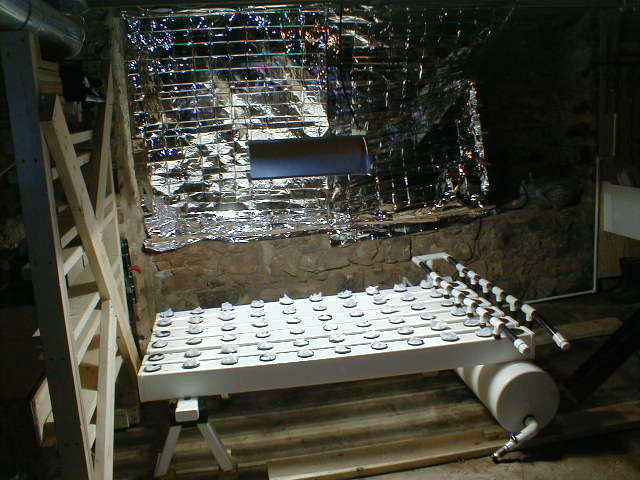 |
| The nutrient level in the chamber is adjusted by the overflow tube height
as illustrated here. The tube shown just above the overflow tube is connected to the nutrient inflow manifold. It sprays a stream of nutrient solution toward the bottom of each pot. |
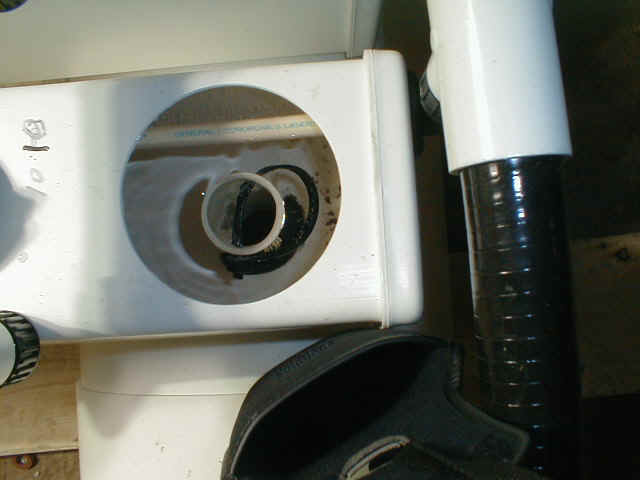 |
| This photo shows a growing pot setting next to it's hole in a nutrient
chamber. The pot is lined with a thin sheet of polywool and filled with
a material called "Grorox" which has a pebble-like feeling, but retains moisture
all over it's surface. Actually I suspected it is nothing but pea gravel but learned
it is a type of ceramic. Seed are placed slightly under the surface of the Grorox. At the time of seed planting the nutrient level in the chambers is adjusted such that it comes within about an inch of the top of the chamber. This floods the pot and keeps both the Polywool and Grorox wet. |
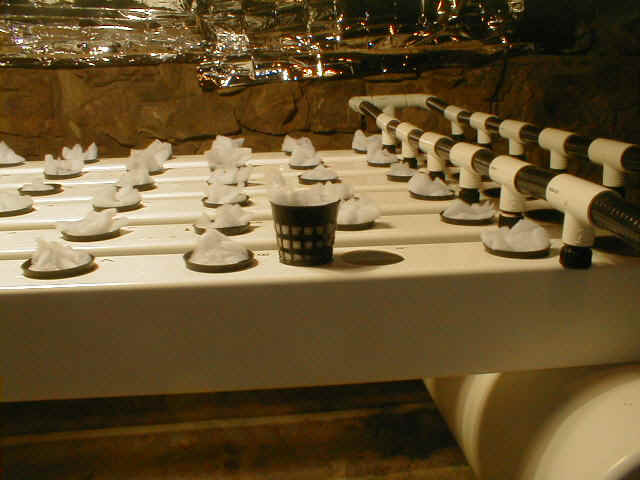 |
| This photo shows the pump end of the large unit. The pump moves the nutrient from the reservoir through a filter and into a manifold which connects to each chamber. As the growing plants get larger they transpire many gallons of water a day. The reservoir has a floating arm actuated valve which allows the water to be replaced as the fluid level in the reservoir decreases. This replacement water comes in from the PVC pipe shown at the far right of the photo. The capacity of the reservoir is 20 gallons with the growing chambers totaling 30 gallons, for a total volume of 50 gallons. |
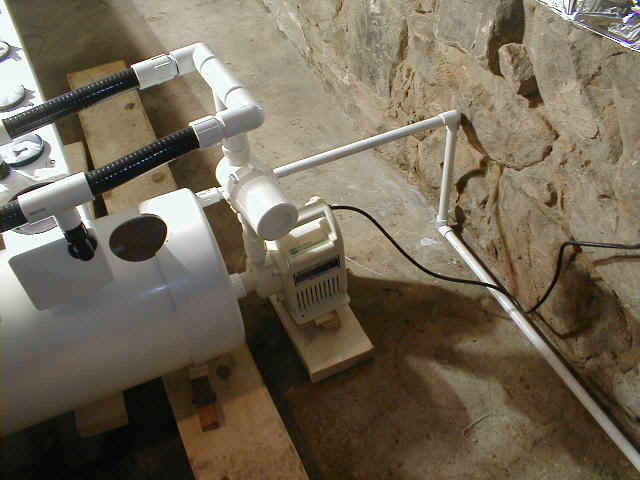 |
| Here you see where the PVC pipe connects to a valve to the cold water
main. When draining the reservoir and nutrient chambers to change the nutrient solution, the second valve from the left is shut off. Once the old nutrient solution has been drained this valve is again turned on to fill the reservoir and growing chambers. Once full, the water intake will automatically be shut off. At that point the correct amount and types of nutrient concentrate is added to the reservoir. |
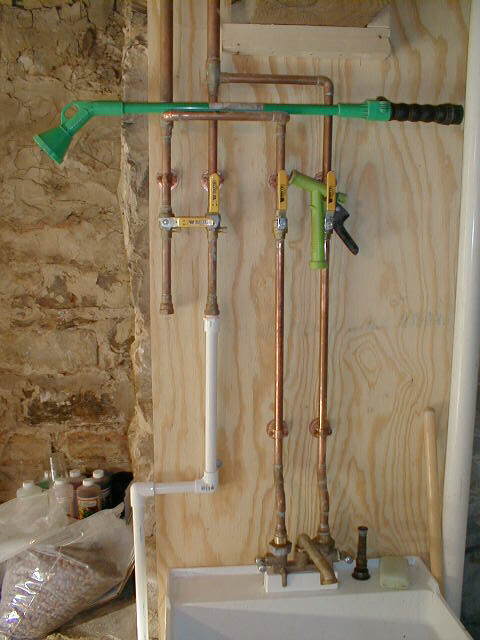 |
| All electrical service in Nancy's home was recently replaced, as the house is over 100 years old. During this electrical upgrade a separate electricity usage meter and breaker box rated at 100 amps was included to service the half of the basement where the TT Inc. Headquarters Laboratory is located. This allows for accurate metering of all electricity used by the basement experiments and demos. This usage will be billed to TT Inc. as it is a significant increase in Nancy's electric bill. | 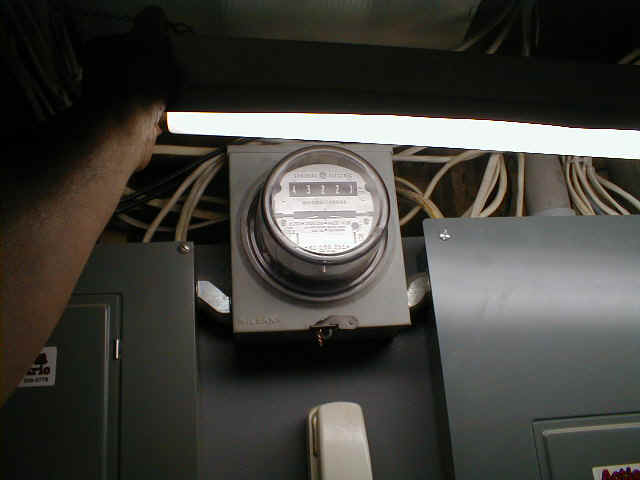 |
| A digital thermometer and relative humidity meter is located next to the
Laboratory equipment and is recorded on a daily basis. As the hydroponically grown plants grow, and when the Aquaponic equipment is installed many gallons of water per day will be released into the basement. The basement is located below the ground surface and has rock walls which remain at an average temperature of the low 60's F. This causes the water vapor in the air to condense on the walls and form a great deal of mildew, which is dangerous to the health of both people and plants. To deal with this situation, two large dehumidifiers have been added. |
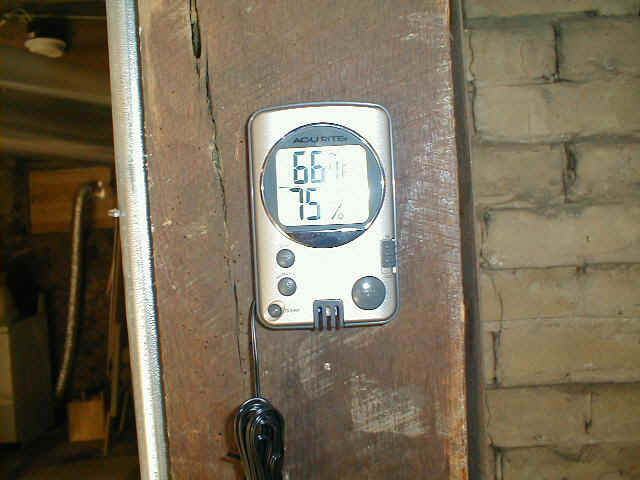 |
This page was produced by Ron Darby.